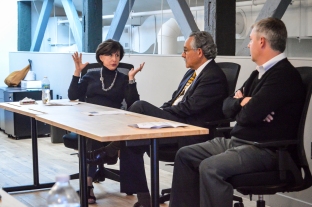Date: October 14, 2016
Location: WeWork Manhattan Laundry
Time: 12:00 pm – 5:00 pm
Led by: Amy Vetal, AICP, LEED AP and Jennie Gwin, AIA
Summary
Jennie Gwin and Amy Vetal organized Session #1, Working Together. The session explored how work culture can enhance opportunities for forming and strengthening organic collaboration. Clarke Consulting donated consulting services for the session and WeWork provided the venue at their newly opened Manhattan Laundry location.


After lunch Cristina Crespo, Latin America Regional Design Lead for WeWork, presented “Changing Work Patterns in the 21st Century.” Six years ago WeWork was founded as a company “to create a world where people work to make a life, not just a living”. Today WeWork has 70,000 members in 110 locations in38 cities. Creating a high design workspace, attractive to creative professionals, providing business services, and building relationships within each location has driven this rapid growth. Ms. Crespo noted that the physical product of a WeWork location is a synthesis of understanding the programing/user mix, technology, how users inhabit the space in real time, and location/local customs. Each location has a signature “design intensive moment” to give a sense of place. Ms. Crespo presented images of the newly opened WeWork Mexico City location. Furnishings in this location are representative of Mexican design and rely on the work of local artists and artisans as well as members of the WeWork community. After the presentation scholars toured the Manhattan Laundry location.


Following the tour Cable Clarke of Clarke Consulting presented “Personal Development: Understanding Thinking Styles”. Prior to the session scholars completed the Life Styles Inventory (LSI) to gain insights into the ways they interact with others. The LSI is formed of twelve different sectors: four aggressive-defensive, four passive-defensive, and four constructive behaviors. Mr. Cable presented a number of organizations and outlined public perception versus internal corporate leadership cultures based on the LSI. The scholars then went on to create help wanted ads based on passive and aggressive behaviors prior to individual LSI results being revealed. The ideal profile, where aggressive and passive responses are minimized, was discussed as well as how to interpret individual results and affect change to improve behaviors. Mr. Clarke noted that the next steps to improving constructive behaviors are awareness, acceptance, and action. Literature for further study of LSI results was provided.


The afternoon’s presentations ended with a discussion of collaboration in the design and building industry. The panel, composed of Hanny Hassan, FAIA, Director of Beyer, Blinder, Belle’s DC office, Brenda Sanchez, FAIA LEED AP, a Senior Architect for the Smithsonian Institution, and Tom Whitmore, Director of Operations for the Historic Preservation Group at The Christman Company was moderated by Ms. Vetal and Ms. Gwin and focused on how to build successful collaborative relationships between contractors, clients, and architects. The discussion centered on questions posed by the scholars earlier in the week. Panelists provided examples of bringing stakeholders into the project at the earliest possible stages for the best results, including one instance of two contractors being involved in pre-design meetings for a competitively bid project. While this was a challenging working relationship, more input yielded a better project. Teams where everyone has worked together and bring a familiarity with the project as well has their own internal dynamics were felt to be highly effective. Mr. Hassan noted: “It’s easier to have a high level of collaboration when you get together on your second date”. As a leadership team we should adopt an “our project” rather than a “my project” mentality.


At the end of an engaging kick-off to the 2016/2017 Christopher Kelly Leadership Development Program, scholars came away with a stronger understanding of dynamic work environments that breed collaboration and community, their own strengths and weaknesses and how to better their lesser traits, and the benefits and challenges of working together as a team. The group retired to Marvin and continued the discussion over rooftop drinks on a beautiful fall evening.
